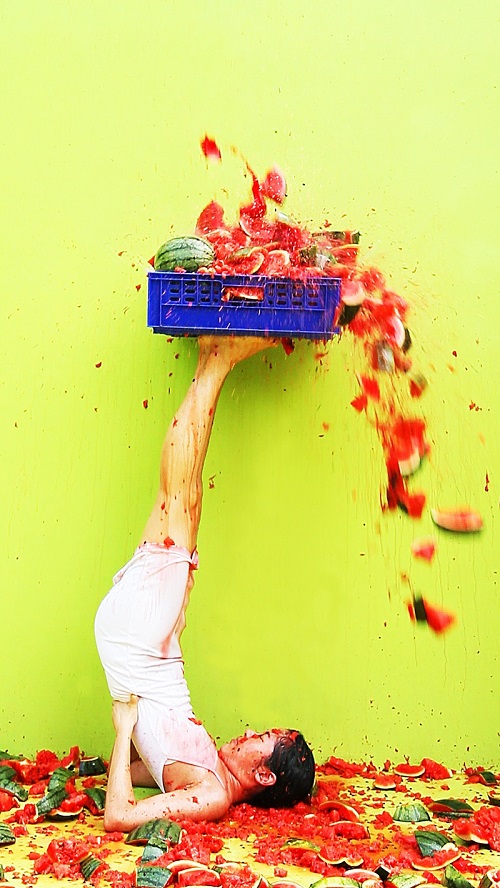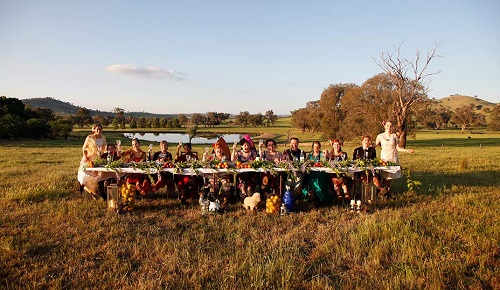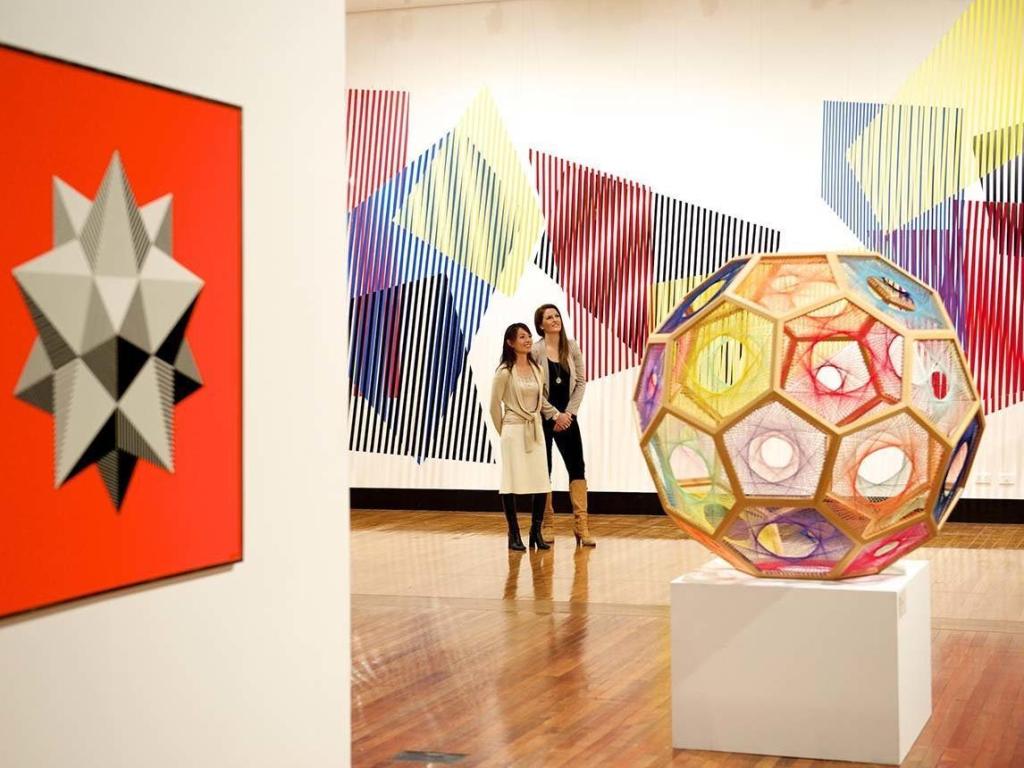Image: Latrobe Regional Gallery.
The reality of working in a regional context means you need to learn to love the road, says Senior Curator at Shepparton Art Museum Anna Briers.
‘Sometimes you might need to change your outfit from the back of your car before you go to an opening, you’ll probably own several toothbrushes and won’t know where any of them are. You may carry strange well-travelled bags of food around – it’s an occupational hazard. Also, you’ll be driving many miles so you’ll either need an abundance of excellent podcasts or numerous rock ‘n’ roll albums.’
Lately, there has been an increased interest in what it means to work regionally. And as many artists (and even some organisations) make the tree change, investment in regional arts is also looking more positive following the Victorian Government’s unprecedented $20 million regional arts package announced in 2015 – which included support for the Small Town Transformations program, managed by Regional Arts Victoria – and the recent announcement of Victoria’s first Regional Centre for Culture program. The program, which will be rolled out in 2018 in the Bendigo, Hepburn, Mt Alexander and Central Goldfields region of Victoria, aims to showcase the strength and diversity of the creative practitioners of the area.
It is also set to debunk any myths surrounding regional arts. Through a year-long series of programs, events and specially commissioned work, it will show that distance from the city doesn’t mean less excitement or less innovation, and it will be city-based residents’ turn to pack the toothbrushes and head to regional areas so they don’t miss out.
Yet despite the innovation we know is happening in our regional arts, misconceptions still persist. ArtsHub asked regional arts workers and artists what myths they want to see busted.
Myth 1: Regional workers must have a constant case of FOMO
Visual artist Jasmine Mansbridge has worked in regional locations across Australia, but now calls Hamilton in western Victoria home. In her experience, working regionally doesn’t result in missing out because social media keeps individual artists up to speed.
At the same time, disconnection really depends on your point of view. As Mansbridge points out, ‘If the misconception is that artists like myself are disconnected then I think the truth is you are able to be more connected to what is most important to you.’
Bruce Gladwin, Artistic Director of Geelong based theatre company Back to Back Theatre, agrees that disconnection isn’t the result of working regionally. ‘We do work in a regional centre, but we appreciate it is not remote or rural. Our geographical home offers a sense of freedom, rather than a disconnection from a cultural epicentre. We are charged with possibility.’
Back to Back is one of Victoria’s most in demand arts companies. It has just returned from Sydney Festival and the ensemble is preparing to tour to the Netherlands. By the year’s end their work will have been seen in Perth, Sydney, the Netherlands, Germany and their home town in Geelong. They are also completing a television project that will see their work screened across the country.
Myth 2: The backwater venue
Briers said one of the biggest misconceptions she has experienced is the notion that SAM is ‘some kind of dinky little gallery in a regional backwater, as opposed to a museum that celebrates cutting edge contemporary art and deep community engagement.’
But this “little” gallery, which houses one of Australia’s most important ceramic art collections, has pulled out all the stops with a successful rebranding campaign and renovation in 2012 and, after receiving an additional $10 million in funding from the Victorian Government last year, plans for a new art museum in the near future.
In the last few years SAM has hosted cutting edge contemporary exhibitions, many of which are exclusive to the Museum. This year SAM is the only Victorian venue to present the collaborative work of Tracey Moffatt and Gary Hillberg in the touring exhibition Montages: The Full Cut, 1999 – 2015.
Myth 3: It’s the job you settled for
People often misunderstand the reasoning behind a regional arts career, operating under the misapprehension that people only work regionally because they didn’t get a city job.
‘There’s a notion that “going regional” might be some kind of teeth cutting exercise or penance that you might undertake before you get a real job at the NGV,’ said Briers.
While there are certainly differences in audience and environment, Briers said working regionally offers a unique opportunity to respond to place and context. This can lead to new and innovative practices and curation that, again, undermines the presumption that working regionally means being disconnected.

Kawita Vatanajyankur, The Scale (still), 2015, single channel HD video, 2:11 minutes. Exhibited at SAM as part of Cornucopia group exhibit. Courtesy the artist and Stills Gallery, Sydney.
‘Small museums can be nimble yet ambitious mechanisms that offer fertile ground for experimentation and artistic leadership, without getting caught in the cogs of larger institutions,’ said Briers.
Regional arts is also a space where history is made and new ground is broken. Less than two years ago in 2015, Southern Grampians Shire Council announced the appointment of Sarah Schmidt, Hamilton Gallery’s first female Director. Her commencement in this role marked the first change of leadership at the Gallery in more than 27 years.
Myth 4: Community isn’t a buzzword
For Lyn Wallis, Artistic Director of HotHouse Theatre in Wodonga, a reality of working regionally is constant community engagement. ‘”Community” is not a notion, it’s real, and it’s up-close-and-personal,’ she said. ‘If an arts organisation isn’t responding to its community, they know it pretty quickly. People are vocal, and they vote with their feet.
‘When people are buying tickets, they tell the box office person what they like and don’t like about season shows, and what they’d like more or less of. My office is right next to the Box Office, so I’m constantly tuning into that conversation!’
The Australia Council’s recent participation statistics confirm a high level of art attendance in regional areas. In Ballarat at least 61% of people in the local community attended an arts venue or event, and the Shepparton community shows similar numbers at 58%.

Image credit: Ben Simpson, OGA. HotHouse Theatre.
Myth 5: Your art isn’t as good
Mansbridge said her art practice is affected positively by the hours she has alone, which gives her time to think about her painting in an insulated environment. ‘I wonder if I had always lived in a city if I would have found the dedication and solitude to work like I do. Either way, it is what it is and it works for me.’
‘Rather than a kind of cultural cringe that I feel once existed towards country artists, more and more I encounter an attitude of curiosity about how artists outside of metro areas live and work, and the possibility that by choosing this path you can have a life that in many ways can be geared towards actual art making. And making great work because you are in that removed environment.’
Myth 6: Regional living comes at the expense of cutting edge practice
It’s just not true that regional organisations sacrifice experimentation. Examples like the Guirguis New Art Prize, run by the Post Office Gallery in Ballarat, Bendigo International Festival of Exploratory Music, and the Ballarat Foto Biennale show us that regional organisations do push boundaries and often work at the cutting edge of contemporary practice.
Briers said SAM combines contemporary arts and community to create innovative new programs. ‘As a regional museum, I think that SAM has a succinct identity which is bound up within its geographic positioning and multi-cultural demographic. We are very interested in site referential projects that stem from local context, and connect with larger global themes. We are for cutting edge contemporary art with deep community engagement.
‘I once heard the expression – if you “go regional” and your program is a particularly average one, no one notices, and if you do amazing things everyone notices. Recently people have been telling me we do amazing things.’
Myth 7: It’s just worse off
Wallis said: ‘The biggest myth is that work in the regions is the “poor cousin” equivalent of what is produced in the major cities. The truth is, the stories, experiences and social dynamics of regional communities are unique, and there are many wonderful artists who choose to work regionally and respond those unique things.’
There are also a lot of benefits to working regionally, for both creative practitioners and arts workers.
‘It isn’t better or worse, it’s different, and it would enrich the lives of city dwellers too, to have more access to it. The regional landscape has changed dramatically in the last ten years, and where ‘the regions’ were once a place to start your career, they have gradually become a space for really experienced artists to live and practice. The things they long for to help them reach their peak creatively: space, light, air, time, affordability – are all here,’ concluded Wallis.
The Inside Creative State Report is brought to you in partnership with Creative Victoria. Creative State is a Victorian Government strategy for growing Victoria’s creative industries across arts and culture, film and television, design, digital games and fashion. The Regional Centre for Culture program is one of the strategy’s 40 actions.





